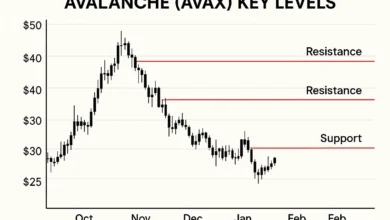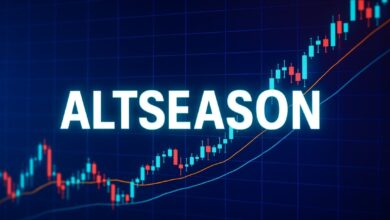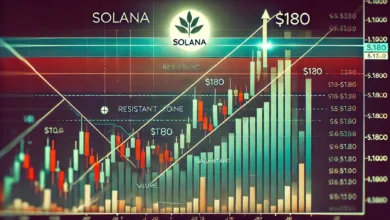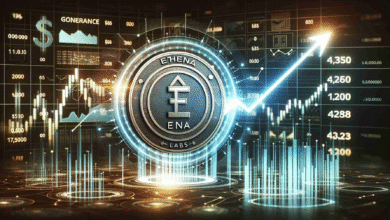Bitwise Launches BWOW Dogecoin ETF on NYSE Trading Platform
Bitwise Launches BWOW Dogecoin ETF. How the new Dogecoin ETF launch impacts crypto investment opportunities in 2025.

Bitwise Asset Management launched its Dogecoin ETF under the ticker BWOW on the New York Stock Exchange on November 26, 2025. This development represents a pivotal moment for digital asset management and mainstream cryptocurrency adoption, Bitwise Launches BWOW Dogecoin: particularly as institutional investors continue exploring alternative investment vehicles beyond traditional Bitcoin and Ethereum products. The emergence of multiple Dogecoin exchange-traded funds signals growing acceptance of memecoin investments within regulated financial markets, though questions remain about sustained demand and long-term viability in an increasingly competitive landscape.
The launch comes at a time when the broader cryptocurrency market experiences mixed sentiment, with technical indicators showing ETF optimism offsetting bearish trends seen in key moving averages. Understanding the implications of this development requires examining the competitive landscape, regulatory environment, and market dynamics shaping the future of cryptocurrency ETF products.
ETF Launch: Bitwise Launches BWOW Dogecoin
The Bitwise Dogecoin ETF represents more than just another investment product entering the market. The management fee is set at 0.34%, with the fee waived completely for the first month on the first $500 million in assets, making it an attractive proposition for early adopters seeking exposure to the popular memecoin. This promotional strategy mirrors tactics used in launching other cryptocurrency products, where fee waivers help build initial momentum and attract assets under management.
Bitwise CEO Hunter Horsley stated that DOGE began as a joke and came to become an icon of the crypto movement, adding that against the odds, it has kept its relevance longer than just about anything else in crypto. This acknowledgment of Dogecoin’s unique position in the cryptocurrency ecosystem reflects a pragmatic approach to meeting investor demand, even for assets that lack traditional utility or fundamental value propositions.
The cryptocurrency ETF structure provides several advantages for investors who want exposure to Dogecoin without managing digital wallets or navigating cryptocurrency exchanges. Coinbase Custody Trust Company, LLC serves as the custodian, addressing security concerns that have historically deterred institutional participation in direct cryptocurrency holdings. This custodial arrangement ensures professional asset management while maintaining the regulatory compliance standards expected in traditional financial markets.
The Growing Dogecoin ETF Competitive Landscape
The BWOW launch occurs within an increasingly crowded field of Dogecoin investment products. The Grayscale Dogecoin ETF began trading on Monday and the REX-Osprey DOGE ETF launched in September, establishing a competitive environment where multiple issuers vie for market share. This proliferation of similar products raises important questions about market fragmentation and whether sufficient demand exists to support multiple Dogecoin-focused investment vehicles.
Early performance indicators suggest varying degrees of success among these competing products. Grayscale’s GDOG traded $1.4 million on its first day, which Bloomberg analyst Eric Balchunas described as a respectable amount. However, this trading volume pales in comparison to the explosive launches witnessed with spot Bitcoin ETFs earlier in the year, highlighting the challenges facing alternative cryptocurrency products in capturing mainstream investor attention.
The structural differences between these products also merit consideration. The REX-Osprey DOGE ETF took a different approach since it is registered under the Investment Company Act of 1940, a federal law that regulates investment funds. This regulatory distinction creates varying levels of investor protection and operational requirements, potentially influencing investor preferences based on risk tolerance and regulatory expectations.
Market observers note that despite its origins as a meme, Dogecoin has held a surprisingly durable place in the digital-asset rankings, remaining the seventh-largest cryptocurrency with a market cap of roughly $22 billion. This sustained market position provides a foundation for ETF viability, though whether this translates into sufficient investment flows remains an open question.
Market Dynamics and Investor Demand Patterns
The memecoin ETF market exhibits characteristics distinct from more established cryptocurrency investment products. Grayscale’s spot Dogecoin ETF recorded no net inflows and just $1.41 million in volume, far below analyst expectations, suggesting that institutional appetite for memecoin exposure may be more limited than promotional materials suggest. This contrasts sharply with other recent cryptocurrency ETF launches that generated substantial first-day interest.
Several factors contribute to this tepid reception. Unlike yield-bearing products such as Bitwise’s Solana staking ETF, Grayscale’s GDOG offers no staking rewards, reducing its appeal compared to cryptocurrency products that generate ongoing returns. This structural disadvantage highlights the challenge facing spot Dogecoin ETFs in attracting investors who increasingly seek yield enhancement alongside capital appreciation potential.
The broader market context also influences demand patterns. With the crypto fear index at 15, indicating extreme fear, and Bitcoin dominance rising, Dogecoin’s path hinges on whether meme coins can regain narrative momentum. These sentiment indicators suggest that timing plays a crucial role in ETF success, with launches occurring during risk-off periods facing steeper adoption curves.
Despite these challenges, certain market segments demonstrate continued interest in Dogecoin investment opportunities. Bitwise acknowledged that the ETF was launched in response to constant pressure from Dogecoin users who favored having an ETF listed, indicating grassroots demand from retail investors who comprise Dogecoin’s core community. Whether this retail enthusiasm translates into sustained investment flows capable of supporting multiple ETF products remains uncertain.
Regulatory Considerations and Risk Factors
The regulatory framework surrounding cryptocurrency exchange-traded funds continues evolving, creating both opportunities and challenges for issuers and investors. The SEC delayed its decision on the BWOW proposal to November 12, 2025, demonstrating ongoing regulatory scrutiny even as approvals become more routine. This review process reflects the Commission’s cautious approach to expanding cryptocurrency investment products beyond established assets like Bitcoin and Ethereum.
Important regulatory distinctions exist between different ETF structures. The ETF has not registered under the Investment Company Act of 1940 and thus is not subject to the regulations that mutual funds and other registered investment products are subject to. This regulatory status affects investor protections and operational requirements, creating a tiered system where some products offer more comprehensive safeguards than others.
Risk disclosures associated with these products underscore their speculative nature. Dogecoin was originally considered a memecoin and may be subject to even greater levels of volatility than other digital assets, as most memecoins have no stated use case or intrinsic value. These warnings reflect the fundamental challenge of marketing investment products based on assets that lack traditional valuation metrics or utility propositions.
The custodial arrangements also carry specific implications. The underlying assets of the ETF will be kept in Coinbase Custody Trust Company, concentrating counterparty risk with a single service provider. While Coinbase maintains strong security protocols, this centralization differs from the distributed custody models some investors prefer for cryptocurrency holdings.
Institutional Adoption and Market Impact
The entrance of established asset management firms into the Dogecoin space signals shifting attitudes toward formerly niche cryptocurrency assets. Bitwise Asset Management is a global crypto asset manager with more than $15 billion in client assets and a suite of over 40 crypto investment products, bringing institutional credibility to what began as an internet joke. This professional management infrastructure provides comfort to investors uncomfortable with direct cryptocurrency ownership.
However, institutional adoption patterns reveal important distinctions between asset classes. Bitcoin still has the biggest role in terms of entry of funds, and there may be interest in other altcoins in terms of ETFs, albeit slowly. This gradual expansion suggests that alternative cryptocurrency ETFs face steeper adoption curves compared to more established digital assets, requiring patient capital and sustained marketing efforts.
The competitive dynamics within the broader crypto ETF market also influence institutional participation. Over the past month, issuers have launched products tied to Solana, XRP, and Dogecoin, with more XRP and Dogecoin funds set to list next week. This rapid product proliferation creates choice for investors while potentially fragmenting available capital across numerous similar vehicles, diluting the impact any single product might achieve.
Market structure considerations further complicate institutional adoption prospects. The Canary Capital XRP ETF debuted with $58 million in net inflows, the highest opening-day haul for any ETF this year, demonstrating that substantial demand exists for certain alternative cryptocurrency products. Whether Dogecoin commands similar interest remains to be seen, with early indicators suggesting more modest appetites.
Price Performance and Technical Analysis
Dogecoin price dynamics have shown significant volatility in the period surrounding ETF launches. DOGE caught a bounce over the weekend, joining a wider memecoin rebound, suggesting that ETF-related news can influence short-term trading patterns. These price movements reflect speculative positioning by traders anticipating increased demand from ETF flows, though whether sustained appreciation follows remains uncertain.
Technical analysis provides additional context for evaluating potential price trajectories. Since early September, DOGE has been tracing a five-wave decline, with the final leg forming an ending diagonal, a pattern traders often view as a sign that a downtrend is running out of steam. These chart patterns interest technical traders who use historical price action to project future movements, though fundamental factors ultimately drive longer-term performance.
The relationship between ETF launches and cryptocurrency prices exhibits complex dynamics. Dogecoin traded modestly higher ahead of the Grayscale ETF launch, with analysts citing meme enthusiasm and institutional inflows as key price drivers. However, the actual impact of ETF flows on underlying asset prices depends on numerous factors, including total assets raised, market liquidity, and broader sentiment conditions.
Longer-term projections reveal substantial uncertainty. By December 2025, Dogecoin price prediction points to a potential year-end close between $0.85 $0.92, assuming macro stability and ETF-driven inflows continue to boost demand. Such forecasts should be viewed skeptically, as cryptocurrency markets frequently defy predictions based on historical patterns or fundamental analysis.
Community Response and Cultural Significance
The Dogecoin community represents a unique force within cryptocurrency markets, distinguished by its grassroots enthusiasm and cultural identity. Bitwise characterized the community’s reaction as ordinary, citing the token’s visibility in retail market trading exchanges. This community engagement provides a foundation of support that distinguishes Dogecoin from purely speculative altcoins lacking dedicated followings.
The cultural narrative surrounding Dogecoin influences its market position in ways that transcend traditional investment metrics. DOGE is simply a 12-year-old coin based on a picture of a cute dog, people doing good, and the common ideal in crypto that people should have the freedom to do as they choose. This philosophical framework resonates with cryptocurrency enthusiasts who value decentralization and financial freedom, even when specific use cases remain underdeveloped.
Social media dynamics continue shaping Dogecoin’s market presence. Created in 2013, the token has outlasted hundreds of short-lived altcoin experiments and built one of the most active online communities in crypto. This longevity and community engagement provide competitive advantages that newer memecoins struggle to replicate, potentially supporting sustained demand for investment products even as fundamentals remain questioned.
The intersection of meme culture and finance creates unique marketing opportunities and challenges. Bitwise stated the company is responding to a real and persistent demand within one of crypto’s most unusual communities. This demand-driven product development differs from top-down asset management strategies, reflecting the democratizing influence of cryptocurrency markets on traditional financial structures.
Future Outlook and Market Evolution
The trajectory of Dogecoin ETF adoption will significantly influence broader cryptocurrency investment product development. If approved, additional ETFs could open DOGE to billions in institutional inflows and cement it as the leading meme coin of 2025. However, this optimistic scenario requires sustained investor interest and favorable market conditions that may not materialize given current sentiment indicators.
Several factors will determine whether Dogecoin ETFs achieve meaningful market penetration. The AI model indicated that Dogecoin’s performance depends on overall industry strength rather than isolated hype-driven momentum. This assessment suggests that memecoin ETFs function as leveraged bets on broader cryptocurrency market performance rather than independent investment theses, limiting their appeal during risk-off periods.
The alternative cryptocurrency ETF space continues evolving rapidly as issuers test investor appetites for increasingly diverse products. Meanwhile, 21Shares is also considering a similar offering and has recently amended its filing with the SEC as part of its effort to expedite approval. This ongoing product development suggests that, regardless of initial performance metrics, issuers remain committed to exploring memecoin investment opportunities.
Longer-term market structure questions also merit consideration. With multiple competing Dogecoin ETFs entering the market, will BWOW’s approval reignite retail interest, or will DOGE remain sidelined in this risk-off market? The answer will provide important signals about cryptocurrency market maturity and the viability of memecoin-focused investment products in mainstream portfolios.
Conclusion
The launch of the Bitwise Dogecoin ETF under ticker BWOW represents both an achievement and a test for cryptocurrency market evolution. While the product provides regulated access to Dogecoin exposure for traditional investors, early performance indicators from competing products suggest that demand may be more limited than promotional materials suggest. The structural challenges facing memecoin ETFs, including lack of yield generation and extreme volatility, create headwinds that even established asset managers must navigate carefully.
The proliferation of multiple Dogecoin investment products within a short timeframe raises questions about market fragmentation and whether sufficient institutional appetite exists to support numerous similar vehicles. Early trading volumes for competing products have disappointed relative to expectations, though proponents argue that building sustainable investment flows requires patience and favorable market conditions that may emerge over time.
Looking forward, the success or failure of Dogecoin ETFs will influence product development across the cryptocurrency investment landscape. If these products attract substantial assets and demonstrate viable business models, expect accelerated launches of ETFs tracking increasingly obscure digital assets. Conversely, if demand remains tepid and operating costs exceed revenue, issuers may refocus efforts on more established cryptocurrencies with clearer investment theses.
For investors considering exposure through these products, careful evaluation of fee structures, regulatory protections, and underlying asset characteristics remains essential. While the convenience of ETF wrappers provides advantages over direct cryptocurrency ownership, the speculative nature of memecoins and their extreme volatility profile demands appropriate position sizing and risk management regardless of investment vehicle structure.
FAQs
Q: What is the Bitwise Dogecoin ETF ticker symbol?
The Bitwise Dogecoin ETF trades under the ticker symbol BWOW on the New York Stock Exchange. The fund provides regulated exposure to Dogecoin price movements through a traditional brokerage account structure, eliminating the need for cryptocurrency wallets or exchange accounts.
Q: How does the Dogecoin ETF differ from owning DOGE directly?
Owning shares in a Dogecoin ETF differs from direct cryptocurrency ownership in several important ways. ETF investors gain exposure through regulated securities that trade during standard market hours, receive tax reporting on standard 1099 forms, and avoid managing digital wallets or private keys.
Q: Why are multiple Dogecoin ETFs launching simultaneously?
The simultaneous launch of multiple Dogecoin ETFs reflects a competitive race among asset managers to capture market share in the emerging memecoin investment product space. Following the successful launches of Bitcoin and Ethereum ETFs, issuers are expanding product offerings to include alternative cryptocurrencies.
Q: Are Dogecoin ETFs suitable for conservative investors?
Dogecoin ETFs are generally not appropriate for conservative investors due to the extreme volatility and speculative nature of the underlying asset. Regulatory disclosures emphasize that Dogecoin lacks fundamental utility or intrinsic value beyond its cultural significance as a memecoin.
Q: What factors will determine Dogecoin ETF success?
The success of Dogecoin ETFs depends on several interrelated factors, including sustained retail investor interest, broader cryptocurrency market performance, regulatory developments, and competitive dynamics among multiple similar products.











